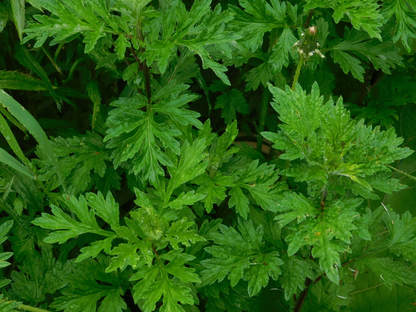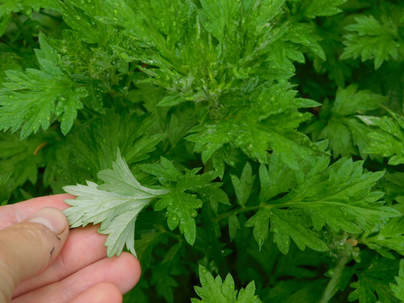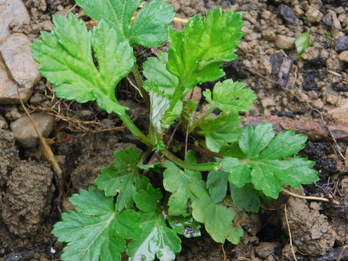 The more my interest in plants continues to grow and the more I learn, the more I realize just how much I don't know! I used to pride myself that I knew many of the wildflowers and plants in this area, but as I take a closer look I realize there are many very interesting and useful plants which I have simply ignored as "weeds"! Among these, to my surprise and slight embarrassment, is an herb I just introduced to my garden this year! I was running in our field the other day when it suddenly dawned on me that some plants growing along my trail, which I've passed countless times before without really noticing, looked a lot like Mugwort! I stopped to look closer and rub the leaves between my hands. Yes, it was the same smell I've noticed when handling the baby plants in my garden, and which Parkinson calls "a resonable good scent". On my return home I started researching and learned what probably everyone who is reading this already knows! Although Mugwort is native to much of Europe, Asia, and Alaska, it has naturalized throughout North America and is even considered by some to be an invasive weed. While I am excited to have such a ready supply, I must admit to having some doubts about its presence in my garden. It is not a very attractive plant in my opinion, which is probably why I never paid any attention to it before! Still, it is useful and has has an interesting past, which is what prompted me to grow it in the first place.  Mugwort is closely related to Wormwood but can be easily distinguished by its darker, more pointed leaves, which are whitish on the underside. This herb has many interesting and nonsensical folk names, including Old Uncle Henry, Naughty Man, Old Man, Sailor's Tobacco, and Felon Herb. It was also commonly known as St. John's plant, or Cingulum Sancti Johannis, because of the belief during the Middle Ages that John the Baptist wore a girdle of the plant in the wilderness. The name Mugwort is probably derived from its use as a flavoring for beer before the introduction of hops. But some have suggested that "mug" does not refer to a cup, but is actually derived from moughte, a moth or maggot, because it was used, along with Wormwood, to repel moths. The "wort" in the name comes from the old English wyrt, which simply means "plant". There are two possibilities for the reason for its botanical name as well. Both Gerard and Parkinson write that it was probably named for Artemesia, wife of King Mansolus of Caria, who adopted it as her emblem. The other possibility, which Parkinson also mentions, is that it was named for the Greek goddess Artemis. Personally, I would rather believe the former! There are all sorts of legends and superstitions about this plant. The following is from Gerard's Herball: "Pliny saith, that the travailer or waifaring man, that hath the herbe tied about him, feeleth no wearisomness at all, and that he who hath it about him can be hurt by no poisonsome medicines, or by any wild beast, neither yet by the sunne it selfe". (How convenient that it grows by my running trail)! Gerard goes on to say that "Many other fantasticall devises invented by Poets are to be seene in the works of auncient writers, tending to witchcraft and sorcerie, and the great dishonor of God: wherefore I do of purpose omit them as things unwoorthie of my recording or your reviewing". Parkinson related another of these superstitions in his Theatrum Botanicum. It was believed that at midnight on St. John's Eve, a "coal" could be found under the roots of Mugwort, which would protect its possessor against many diseases and misfortunes. But he laments, "Oh the weake and fraile nature of man! which I cannot but lament, that is more prone to beleeve and relye upon such impostures, than upon the ordinances of God in his creatures and trust in his providence". The legends associated with it are too numerous to relate, but I did find this Russian tale to be fascinating, if a little odd... In the district of Starodubsk, on the Feast of the Exaltation of the Cross, a young girl was gathering mushrooms in a forest when she came upon a group of serpents coiled up. She tried to back away but fell into a deep pit which was also full of serpents. At the bottom of this pit she found a luminous stone, which the serpents licked to satisfy their hunger. The girl did the same and stayed in the pit until spring, when the serpents linked themselves together to form a ladder for her to escape. As a parting gift, the queen of the serpents gave her the ability to understand the language of plants and their medicinal qualities, but warned her that if she ever mentioned the name of the herb called Tchornobil (mugwort), the gift would be taken away. The girl became famous for her knowledge of plants, and was careful not to speak the name of the forbidden herb. But one day, a man suddenly asked her, "What is the plant which grows in the fields by the side of the little footpaths?". Caught by surprise, she replied that it was called Tchornobil, and immediately the knowledge of plants left her.  Mugwort is still used medicinally for a wide variety of complaints including stomach pain, poor appetite, nervousness, insomnia, colds, asthma, menstrual cramps, and to expel worms! According to a Scottish legend, a mermaid from the Firth of Clyde saw the funeral procession for a girl who had died of consumption and exclaimed, "If they wad drink Nettle in March, And eat Muggins [Mugwort] in May, Sae mony braw maidens Wad not go to clay." An interesting "side-effect" of this herb, and one of the main reasons I wanted to try it, is that it has been known to cause vivid, almost technicolor dreams! Mugwort is also said to be good for sheep, and Mrs. Grieve says that it "may, perhaps, be the Artemesia of Pontos, which was celebrated among the ancients for fattening these animals". It is supposed to be good for poultry as well. Quite a history for an invasive weed! Maybe it will not be out of place in my garden after all? What do you think?
9 Comments
Joyce Marshall
6/15/2018 07:14:36 pm
Is this the same plant as St. John's wort?
Reply
Linda Persson Grill
6/16/2018 11:09:22 am
Mugwort soap takes the sting out of poison ivy and poison oak rashes. It is used by "over 25 Fire Agencies as well as the US Forest Service (USFS), Bureau of Land Management (BLM), CalFire, mountain bikers, hikers, kayakers, and trail workers everywhere" according to the Paradise Road Soap Company. My son and my husband, have used it many times.
Reply
Kerrie
5/21/2021 07:01:56 am
Is it edible freshly picked or does it need to be dried and used like tobacco or like dried parsley if used medicinally
Reply
Leave a Reply. |
AuthorI am a passionate gardener and seed-saver, who also enjoys playing the violin and accordion, running, spending time with my 4 golden retrievers, keeping chickens, photography, and reading. Archives
March 2019
|

 RSS Feed
RSS Feed
